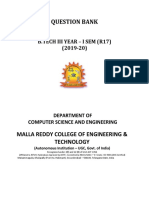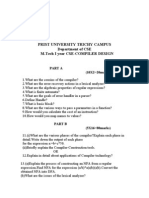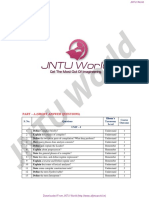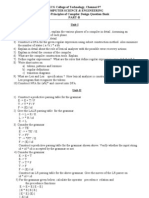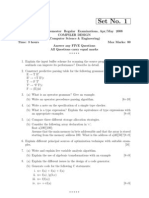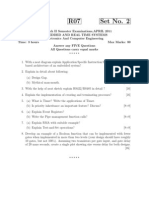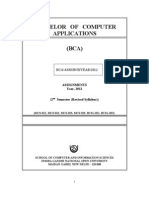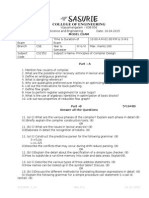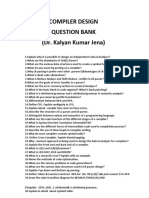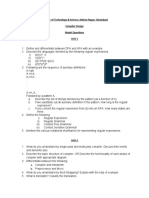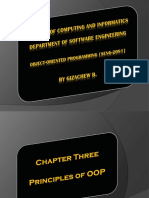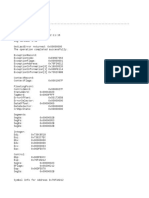CD
CD
Uploaded by
Arun DhawanCopyright:
Available Formats
CD
CD
Uploaded by
Arun DhawanOriginal Description:
Copyright
Available Formats
Share this document
Did you find this document useful?
Is this content inappropriate?
Copyright:
Available Formats
CD
CD
Uploaded by
Arun DhawanCopyright:
Available Formats
QUESTION BANK
2016
SIDDHARTH GROUP OF INSTITUTIONS :: PUTTUR
Siddharth Nagar, Narayanavanam Road 517583
QUESTION BANK (DESCRIPTIVE)
Subject with Code : Compiler Design (13A05502)
Course & Branch : B. Tech - CSE
Year & Sem : III B.Tech & I-Sem
Regulation : R13
UNIT-1
1.Explain the need for dividing the compilation process into various phases and explain
itsfunctions. Explain how abstract stack machine can be used as translators.
[L2,
10M]
2. a) Describe the role performed by lexical analysis of the compiler
[L1, 5M]
b) Explain the need of code optimization in compiler
[L2, 5M]
3. Explain programming language basics in detail.
[L2, 10M]
4. a) Explain Symbol table management and error handling technique in compiler [L2, 5M]
b) Differentiate between compiler and interpreter.
[L4, 5M]
5. a)Explain construction tools in compiler
[L2, 5M]
b) Explain the different Language processor of a program.
[L2, 5M]
6. Define LEX. Explain the use and form of lex program with an example.
[L1, 10M]
7 Write short notes
[L6, 5+5M]
a) pass and phases of a compiler
b) bootstrapping
8. Explain briefly how to recognize tokens in lexical analysis.
[L2, 10M]
9. Write short notes
[L6, 5+5M]
a) Application of compiler technology
b) Parts of compiler
10
a)List the various phases of a compiler.
[L1, 2M]
b)Differentiate tokens, patterns, lexeme.
[L4, 2M]
c) List the operations on languages.
[L1, 2M]
d)Define Regular Expressions and Regular Grammar.
[L1, 2M]
e) List the various error recovery strategies for a lexical analysis.
[L1, 2M]
UNIT-2
1.a) Construct the recursive decent parser for the string id*(id+id) following grammar?
[L4, 5M]
E-> E+T/T
T-> T*F/F
F-> (E)/id
b) Explain about Left factoring with an example?
[L2, 5M]
2. Define augmented grammar? Construct the LR(0) items for the following Grammar?
S->L=R
[L1, 10M]
S->R
L->*R
COMPILER DESIGN
Page 1
QUESTION BANK
2016
L->id
R->L
3. Calculate first and follow for the following grammar?
[L3, 5M]
a) E-> E+T/T
T-> T*F/F
F-> (E)/id
b) S->xABC
[L3, 5M]
A->a|bbD
B->a|
C->b|
D->c|
4. Consider the grammar E->E+T,T->T*F,F->(E)|id. Using predictive parsing table parse the
string id+id*id.
[L3, 10M]
5. Perform Shift Reduce Parsing for the input string (id*id+id) fr the following. [L3, 10M]
E-> E+E|E*E|(E)|id
6. a) For the given grammar S->cAd , A->ab|a , draw the parser tree for the input string w=cad
using recursive descent parsing with backtracking.
[L4, 5M]
b) For the given grammar T->dFa F->bg|b , draw the parser tree for the input string w=dba
using recursive descent parsing with backtracking.
[L4, 5M]
7. Consider the grammar
S->AB|ABad
A->d
E ->b
D->b|
B->c
Derive the predictive parsing table. Show that the given grammar is LL(1) or not [L3, 10M]
8. Consider the grammar S->xABC
A->a|bbD
B->a|
C->b|
D->c|
Derive the predictive parsing table.
[L3, 10M]
9. Perform Shift Reduce Parsing for the input string using the grammar.
[L4, 5+5M]
S->(L)|a
L->L,S|S
a) (a,(a,a))
b) (a,a)
10
a) What is phrase level error recovery?
[L1, 2M]
b) What are the different strategies of error recovery?.
[L1, 2M]
c) Define Left factoring.
[L1, 2M]
d) What is Shift Reduce parsing?.
[L1, 2M]
e) What is ambiguous grammar?Give an example.
[L2, 2M]
COMPILER DESIGN
Page 2
QUESTION BANK
2016
UNIT-3
1. Explain syntax directed definition.
[L2, 10M]
2. Describe the evaluation order of SDT with an example.
[L5, 10M]
3. Explain the type expression and type equivalence.
[L2, 10M]
4. Explain the Translation scheme of SDD.
[L2, 10M]
5. Describe the different representation of 3-address code with an example.
[L5, 10M]
6. Explain in detail about Backpatching Techniques?.
[L2, 10M]
7. Explain the applications of Syntax Directed Definition.
[L2, 10M]
8. Write down the translation procedure for control statement and switch statement[L6, 10M]
9. Explain different types of intermediate code with an example.
[L2, 10M]
10
a) Define a syntax-directed translation.
[L1, 2M]
b) Define annotated parse tree.
[L1, 2M]
c) What are the three functions of backpatching?
[L1, 2M]
d) Write the Syntax of case statement?.
[L6, 2M]
e) Differentiate between L attribute and S attribute.
[L4, 2M]
UNIT-4
1. Draw the format of Activation Record in stack allocation and explain each field in it.
[L4, 10M]
2. Explain about Induction variable & Global data flow analysis.
[L2, 10M]
3. Explain about the loop optimization techniques with an example.
[L2, 10M]
4. Define Symbol table. Explain different types of Data structure for symbol table [L1, 10M]
5. Distinguish between static scope and dynamic scope. Briefly explain access to non-local
names in static scope.
[L4, 10M]
6. Explain the basic principles source of optimization.
[L2, 10M]
7. Explain basic concept of static and dynamic storage allocation.
[L2, 10M]
8. Explain heap management mechanism.
[L2, 10M]
9. Write briefly reference counting garbage collectors.
[L6, 10M]
10
a) Write any four algebraic simplification
[L6, 2M]
b) Name any four procedural optimization techniques
[L6, 2M]
c) Define scope and life time of variable.
[L1, 2M]
d) Define symbol table.
[L1, 2M]
e) What is meant by data flow equation?.
[L1, 2M]
UNIT-5
1. Write about all issues in code generation. Describe it.
2. Explain the target machine architecture?
3. Write about code scheduling.
4. Describe the various strategies in register allocation.
COMPILER DESIGN
[L6, 10M]
[L2, 10M]
[L6, 10M]
[L5, 10M]
Page 3
QUESTION BANK
5. Explain the peephole optimization?.
6. Construct the DAG for following statement. a+b*c+d+b*c
7. Construct the DAG for the following basic blocks
2016
[L2, 10M]
[L3, 10M]
[L3, 10M]
1. t1:=4*i
2. t2:=a[t1]
3. t3:=4*i
4. t4:=b[t3]
5. t5:=t2*t4
6. t6:=prod+t5
7. prod:=t6
8. t7:=i+1
9. i:=t7
10. if i<=20 goto 1
8. Explain the simple code generator and generate target code sequence for the following
statement d:=(a-b)+(a-c)+(a-c)
[L2, 10M]
9. Write short notes on i)Simple code generator
[L6, 5+5M]
ii) Register allocation
10
a) What is the role of peephole optimization in compilation process
[L1, 2M]
b) Write the issues in the design of a code generator.(any 4)
[L6, 2M]
c) Give the variety of forms in target program
[L1, 2M]
d) Give the application of DAG.
[L1, 2M]
e) Define Dead-code elimination with example.
[L1, 2M]
COMPILER DESIGN
Page 4
QUESTION BANK
2016
SIDDHARTH GROUP OF INSTITUTIONS :: PUTTUR
Siddharth Nagar, Narayanavanam Road 517583
QUESTION BANK (OBJECTIVE)
Subject with Code : Compiler Design (13A05502)
Course & Branch : B. Tech - CSE
Year & Sem : III B.Tech & I-Sem
Regulation : R13
UNIT-1
1. Popular type of intermediate code generation language
[
]
A) 3 address code
B) 33 address code
C) 30 address code
D) 333 address code
2. In code generation the optimizing code is converted into _________
[
]
A) Assembly level language
B) Machine level language
C) Mission code
D) Both A & C
3. How many times the source code will be scanned is called ________
[
]
A) Pass
B) Phase
C) Parse
D) Scanner
4. The logical operation for each part of the process of compilation is called _____[
]
A) Pass
B) Phase
C) Parse
D) Scanner
5. Which is property of boot strapping?
[
]
A) It must compile source language s
B) It must use implementation language i
C) It must generate target language T
D) All the above
6. Cross compiler runs program in one program and does not produce target code for ___
[
]
A) Same machine
B) Another machine
C) Both A&B
D) None
7. Which is not compiler construction tool _________
[
]
A) Parser
B) Scanner generator
C) Data flow synthesis
D) None
8. Token means sequence of _______
[
]
A) Integers
B) Floats
C) Characters
D) All the above
9. Low level programs are ______ to write
[
]
A) Easier
B) Harder
C) Softer
D) Light
10. __________ is a grouping of declarations and statements
[
]
A) Scope
B) Block
C) Shelves
D) Racks
11. ___ directly executes the operations specified in the source program on inputs supplied by
the user.
[
]
A) Interpreter
B) Target program
C) Machine language
D) Assembly language
12. The _________ resolves external memory addresses.
[
]
COMPILER DESIGN
Page 5
QUESTION BANK
2016
A) Translator
B) Virtual machine
C) Linker
D) Pre processor
13.The ________ part breaks up the source program into constituent pieces and imposes a
grammatical structure on them.
[
]
A) Synthesis
B) Analysis
C) Analytical
D) Syntax
14. Information about the source program and stores in _________
[
]
A) Syntax table
B) Analytical table
C) Symbol table
D) Synthetic table
15. The analysis part often called________
[
]
A) Right end
B) Left end
C) Back end
D) Front end
16. The first phase of compiler is called ______
[
]
A) Lexical analysis
B) Scanning
C) Lexical scanning
D) Both A&B
17. The lexical analyzer produces output in the form ________
[
]
A) (token-name, attribute-value)
B) (token-value, attribute-name)
C) (attribute-value, token-name)
D) (attribute-name, token-value)
18. ___ gathers type information and saves it in either the syntax tree or the symbol table.
[
]
A) Lexical analyzer
B) Syntax analyzer
C) Semantic analyzer
D) Analyzer
19. An important part of semantic analyzer is _____
[
]
A) Generating tokens
B) parser tree generation
C) Type checking
D) None of these
20. Syntax trees are commonly used during ______
[
]
A) Syntax analysis
B) Lexical analysis
C) Semantic analysis
D) Both A & C
21. The closure of L denoted as ______
[
]
A) L*
B) L+
C) L*
D) L0
0
22. L is called ________
[
]
A) Concatenation of Zero terms
B) Closure of zero terms
C) Union of Zero terms
D) None
23. Which has highest precedence
[
]
A) *
B) Concatenation
C) |
D) All
24. Transition diagrams have collection of a nodes or circles called ______
[
]
A) Positions
B) States
C) Stages
D) Edges
25. The lexical analyzer tool is called ____
[
]
A) LUX
B) LEX
C) FLEX
D) LES
26. When several prefixes of the input match one or more patterns _____
[
]
A) Always prefer longer prefix to a shorter prefix
B) Always prefer shorter prefix to a longer prefix
C) Both A&B
D) None
27. The latter file is compiled by the C compiler into a file called _______
[
]
COMPILER DESIGN
Page 6
QUESTION BANK
2016
A) a out
B) aout
C) A.Out
D) a.out
28. The translation rules the form
[
]
A) Pattern {Action}
B) {Pattern} Action
C) Pattern {Action}
D) Pattern Action
29. The set{0,1} is the __________
[
]
A) Decimal set
B) Octal set
C) Binary set
D) None
30. The _______ is a special character that cannot be a part of source program
[
]
A) Sentence
B) Word
C) Sentinels
D) Tokens
31. Change in one variable to change another is called _______
[
]
A) Aliasing
B) Changing
C) Differentiating
D) Renaming
32. Parameters are passed from a calling procedure to the callee by ________
[
]
A) Value
B) Reference
C) Both A&B
D) None
33. Analysis portion of a compiler generally separated into _________
[
]
A) Lexical analysis & parsing
B) Lexical analysis & scanning
C) Lexical analysis &syntax analysis
D) Lexical analysis &semantic analysis
34. A ________ is a description of form that the lexeme of a token may take
[
]
A) Syntax
B) Procedure
C) Pattern
D) Function
35. _________ is any finite set of symbols
[
]
A) Strings
B) Characters
C) Alphabets
D) Numbers
36. _________ is example of alphabet used in software systems.
[
]
A) C
B) D
C) ASCII
D) Both A & B
37. Finite sequence of symbols is called _________
[
]
A) String
B) Words
C) Sentence
D) All the above
38. If x=dog y=house then xy= ____
[
]
A) Dog House
B) doghouse
C) DOGHOUSE
D) DogHouse
39. If x & y are strings, then the concatenation of x & y denoted _______
[
]
A) x*y
B) xy
C) XY
D) X*Y
40. The Positive closure of L denoted as ______
[
]
A) L*
B)L+
C) L*
D) L0
COMPILER DESIGN
Page 7
QUESTION BANK
2016
UNIT-2
1. Context Free grammar production rule ____
[
A) a->b
B) A->b
C) A->B
D) A->
2. S->AB,A->a/b, B->b grammar can produce ____ strings
[
A) b
B) ba
C) AB
D) None
3. Which one is not a LR(0) item ____
[
A) A->. Xyz
B) A->x.yz
C) A->xyz
D) None
4. FIRST (a) ____
[
A) A
B) a
C) Both A & B
D) None
5. In LL(1) first L stands for ____
[
A) Left most derivation
B) Scanning from left to right
C) Both A & B
D) None
6. The parsing table has no multiple entries is set to be ____
[
A) LL(1)
B) LL(0)
C) Predictive parser
D) Non recursive parser
7. Follow(start symbol of grammar) should add ____
[
A) +
B) a
C) A
D) $
8. In shift action the input symbol is ____
[
A) Shifted to the stack
B) Reduced with non terminal
C) Both A & B
D) None
9. In synthesized attribute node value is calculated from ____
[
A) Leaves to root
B) From top to bottom
C) Both A & B
D) None
10. In Lex specifications the translation rules starts and ends with ____
[
A) %,%
B) Begin, End
C) %%,%%
D) Start ,Stop
11. A parser which is a variant of top-down parsing without backtracking is_____ [
A) Recursive Descend
B) Operator Precedence
C) LL (1) parser
D) LALR Parser
12. The legal text which is derived from a distinguished symbol is called ____
[
A) Axioms
B) lexemes
C) sentence symbol
D) both A & C
13. A LL parser is also known as
[
A) Top down parser
B) Bottom up parser
C) LL(0)parser
D) LL(1)parser
14. Symbols that cannot be replaced are known as _____
[
A) Non-terminals
B) Terminals
C) Symbols
D) tokens
15. Terminals represent character strings that are recognized by _______
[
A) Syntax analyser
B) lexical analyser
C) semantic analyzer
D) none of these
16. What the letter T represents in production symbols ____
[
A) Term
B) Token
COMPILER DESIGN
Page 8
QUESTION BANK
2016
C) Table
D) None of these
17. Yaac is available as a command on _____
[
]
A) MNIX
B) UNIX
C) DOS
D) None of these
18. The process which starts from the leaf node and ends with the starting symbol is
known as ______
[
]
A) Top down parsing
B) Bottom up parsing
C) Recursive parsing
D) LL(1)parser
19. Which action in the shift reduce parsing detect the syntax errors
[
]
A) ACTION
B) GOTO
C) Error
D) Reduce
20. The simplest method for shift reduced parser is known as ______
[
]
A) SLR
B) LALR
C) CLR
D) LR
21. _____ is an attribute whose value at a node in a parse tree is defined in terms of attribute
at the parent and/or sibling of that node.
[
]
A) L-attribute
B) S-attribute
C) Synthesized
D) Inherited
22. In shift action the input symbol is ____
[
]
A) Shifted to the stack
B) Reduced with non terminal
C) Both A & B
D) None
23. ________ is a recursive descent parser that needs no backtracking.
[
]
A) Predictive Parser
B) LR
C) Brute Force
D) Shift Reduce
24. An attribute grammar in which all attributes are__ then it is called S attributed grammar.
[
]
A) Parsed
B) Inherited
C) A-attributed
D) synthesized
25. The Output From second phase ____
[
]
A) Parse tree
B) Intermediate Code
C) Tokens
D) None
26. The Output From last phase ____
[
]
A) Parse tree
B) Syntax tree
C) Assembly language
D) Both A & B
27. In parse tree the leaf node is labeled by ____
[
]
A) Epsilon ()
B) Terminal
C) Non terminal
D) Start symbol of grammar
28. In top down parsers the parse tree constructed from ____
[
]
A) Bottom to top
B) Top to bottom
C) Both A & B
D) None
29. E-> E*E consists ____
[
]
A) Left factoring
B) Left recursion
C) Both A & B
D) None
30. In LL(1) first L stands for ____
[
]
A) Left most derivation
B) Scanning from left to right
C) Both A & B
D) None
31. FIRST(+) ____
[
]
A) +
B) +,C)+,-,*
D)None
COMPILER DESIGN
Page 9
QUESTION BANK
2016
32. The parsing table has no multiple entries is set to be ____
[
A) LL(1)
B) LL(0)
C) Predictive parser
D) Non recursive parser
33. Which of the following is most powerful bottom up parser?
[
A) SLR
B) LALR
C) CLR
D) Operator Precedence
34. In Reduce action the input symbol is ____
[
A) Shifted to the stack
B) Reduced with non terminal
C) Both A & B
D) None
35. LALR(1) grammar is ____
[
A) LR(0)
B) SLR(1)
C) LR(1)
D) None
36. In bottom up parsing string is generated from ____
[
A) RMD in reverse order
B) Leftmost derivation
C) Both A & B
D) None
37. A parser which is a variant of top-down parsing without backtracking is_____ [
A) Recursive Descend
B) Operator Precedence
C) LL(1) Parser
D) LALR Parser
38. The legal text which is derived from a distinguished symbol is called____
[
A) Axioms
B) Lexemes
C) Sentence symbol
D) Both A & C
39. A LL parser is also known as
[
A) Top down parser
B) Bottom up parser
C) LL(0)parser
D) LL(1)parser
40. The end of file is represented by the special symbol is ____
[
A) $
B)
C)
D)
COMPILER DESIGN
Page 10
QUESTION BANK
2016
UNIT-3
1.Advantage of panic mode of error recovery is that_____
[
]
A)It is simple to implement
B)It never gets into an infinite loop
C)Both A) and B)
D) None of these
2.An Intermediate code form is______
[
]
A)Postfix notation
B)Syntax trees
C)Three address code
D)All of these
3.Intermediate code generation phase gets input from______
[
]
A)Lexical analyser
B) Syntax analyser
C)Semantic analyser
D)Error Handling
4.Relocating bits used by relocating loader are specified by_____
[
]
A)Relocating loader itself
B)Linker
C)Assembler
D)Macro Processor
5.Reduction in strength means
[
]
A)Replacing run time computation by compile time computation
B)Removing loop invariant computation
C)Removing common sub expression
D)None of these
6. The computer languages are generally translated into _____
[
]
A) Assembly
B) Machine
C) Pascal
D) FORTRAN
7.Any statement that immediately follows a goto or conditional goto statement in a sequence of
three address statements is a __________.
[
]
A) Leader
B) Instructor
C) A& B
D) none
8.General Form of a three-address statement is ________________
[
]
A)a:=b (op) c
B) a:=b c
C) a:=b
D)None of these
9. The value of _________________ attribute is computed from the value of attributes at the
siblings and parent of that node.
[
]
A) S-attribute
B) Synthesized
C) Inherited
D) All Above
10 Synthesized attributes can be easily simulated by ______
[
]
A)LL grammar
B)LR Grammar
C) Operator grammar
D) Ambiguous grammar.
11.A Parse tree showing the values of attributes at each node is called________ [
]
A) Syntax
B) Augmented
C) Annotated
D) Semantic
12. S-attribute definition is also called as________.
[
]
A)Postfix SDT
B) Prefix SDT
C) SDT
D)none
13. The information associated with data variables are_____
[
]
COMPILER DESIGN
Page 11
QUESTION BANK
2016
A)Name
B)Data types
C)Scopes, binding& life time
D)All Above
14._____ are the examples for high level Intermediate languages.
[
]
A)Abstract Syntax Tree (AST)
B)Postfix notation
C) both A & B
D) none of these
15. Three address code is a ______level intermediate language
[
]
A) High
B) Medium
C) Low
D) none
16.______ is the process of replacing a function call with the body of the called function.
[
]
A) Inlining function
B) friend function
C) both A & B
D) none
17.The intermediate optimized code can be sequence of _______
[
]
A) Quadruples
B)target code
C)source program
D)binary language
18. Variable descriptors are also known as ___
[
]
A) register descriptor
B)address variables
C) pseudo registers
D)constants
19.An _______ attribute at node N is defined only in terms of attribute values at Ns parent, N
itself and Ns siblings.
[
]
A) synthesized
B) Inherited
C) A & B
D) None
20.A ______ graph depicts the flow of information among the attribute instances in a particular
parse tree.
[
]
A) dependency
B) annotated parse
C) syntax
D) none
21.The fields of Triples are op,arg1 & ____
[
]
A) Result
B) arg2
C) operands
D) none
22.object program is a _____
[
]
A) Program written in machine language
B) Program to be translated into machine language.
C) Translation of high level language into machine language.
D) none of these
23.When is the type checking usually done?
[
]
A) During syntax directed translation B) During lexical analysis
C) During code optimization
D) During syntax analysis
24. Implicit type conversions, is__________
[
]
A)Done automatically by the compiler.
B) Done automatically by the User
C) Done automatically by the OS
D) None of these
25.In synthesized attribute node value is calculated from ____
[
]
A) Leaves to root
B)From top to bottom
C)Both A & B
D)None
COMPILER DESIGN
Page 12
QUESTION BANK
2016
26. ____________is an attribute whose value at a node in a parse tree is defined in terms of
attribute at the parent and/or sibling of that node.
[
]
A) L-attribute
B)S-attribute
C) Synthesized
D) Inherited
27. An attribute grammar in which all attributes are______ then it is called S attributed
grammar.
[
]
A) Parsed
B)Inherited
C) A-attributed
D) synthesized
28. An attribute grammar in which all the attributes are synthesized is called____Attributed
grammar.
[
]
A) P
B )Q
C) R
D) S
29. A _____ keeps the information about each register.
[
]
A) Register descriptor
B) address descriptor
C) variable descriptor
D) none of these
30. In quadruple notation maximum______ fields are used to represent operands. [
]
A) 1
B)2
C) 3
D) 4
31. Which of the following is an intermediate code form_____
[
]
A) Three address code
B) syntax tree
C) parser
D) none of these.
32.A parse tree showing the values of its attribute is called ______
[
]
A)Dependency Graph
B)parse tree
C) Annonated parse tree
D) None
33. A Type name is______
[
]
A)Type expression
B)Type Checking
C) Backpatching
D) None
34. Makelist(i) is a function of______
[
]
A)Type expression
B)Type Checking
C) Backpatching
D) None
35. Syntax directed translation scheme is desirable because ___
[
]
A)It is based on the syntax
B)It is easy to modify
C)Its description is independent of any implementation
D)All of these
36. If Conversion from one type to another type is done automatically by the complier then, it
is called__
[
]
A)Implicit conversion
B)Coercions
C) Both A & B
D) None of these
37.The term environment in programming language semantics is said as ____
[
]
A) Function that maps a name to value held there
B)Function that maps a name to storage location
C)The function that maps a storage location to the value held there
COMPILER DESIGN
Page 13
QUESTION BANK
2016
D)None of the above
38.A self relocating program is one which _______
[
]
A) cannot be made to execute in any area of storage other than the designated for it at
the time of its coding or translation
B) Consists of a program and relevant information for its relocation
C) Can itself perform the relocation of its address sensitive protions
D) All of the above
39.In a bottom up evaluation of a syntax direction definition, inherited attributes can
[
]
A) Always be evaluated
B) Be evaluated only if the definition is L attributed
C) Be evaluated only if the definition has synthesized attributes
D) None of the above
40. Generation of intermediate code based on a abstract machine model is useful in compilers
because
[
]
A) it makes implementation of lexical analysis and syntax analysis easier
B)syntax directed translation can be written for intermediate code generation.
C)It enhances the portability of the front end of the compiler
D)it is not possible to generate code for real machines directly from high level language
programs
COMPILER DESIGN
Page 14
QUESTION BANK
2016
UNIT-4
1. The symbol table Implementation is based on the property of locality of reference is ___
[
]
A)Linear list
B) Search tree
C) Hash Table
D) Self-organizing list
2.Which one of the following is an object code form?
[
]
A)Absolute machine language
B) Re-locatable machine code
C) Assembly language
D) all of the above
3.The statement of the form a:=b is called a _____ statement.
[
]
A)Common
B) Copy
C) Induction Variable
D) Decode
4.To check whether a variable is exactly defined once or not is a ________ check. [
]
A) Uniqueness check
B) Flow of Control Check
C) name check
D) Above all
5. ___ is a Data Structure, which is used by compiler to keep track of information [
]
A) Lexical analyser
B) Symbol Table
C) Semantic Table
D) Semantic Analyzer
6. A symbol is said to be ____if it has different meaning depending on its context or use.
[
]
A) Override
B)Overloaded
C) Overwrite
D) None
7.The storage strategy in which activation record is maintained even after the execution of a
procedure is completed.
[
]
A) Stack Allocation
B) Heap Allocation
C) Static Allocation
D) Dynamic Allocation
8.An optimized compiler can perform _________
[
]
A) Optimize the code
B) Expand the Code
C) Reporting Errors
D) Above all.
9.Machine independent optimization is_____
[
]
A) Register Allocation
B) Frequency reduction
C) Data intermixed with instruction
D) None
10. A __________ can be visualized as a set of records in data structure.
[
]
A)Symbol table
B) Variable
C) both A & B
D) none
11.A hash function should produce the same hash value for two different keys then it is called
______
[
]
A)collisions
B) Heap allocation
C) Stack allocation
D) none of these.
12. Set of information constitute a record in dynamic allocation is called _____ [
]
A)Activation Record (AR)
B)frame.
C) both A & B
D) none of these
13. The process of replacing the costly instruction by cheaper one is called ____. [
]
COMPILER DESIGN
Page 15
QUESTION BANK
2016
A)Strength Reduction
B)Strength Increases
C) Induction Variable
D) none
14.A movement of data from memory to register or register to memory is considered as ______
cost.
[
]
A) code
B) unit
C) register
D) none
15.SISD full form ______
[
]
A)Single Instruction Single Data
B)Set of Instruction Single Data
C) Single Instruction Set of Data
D) none of these.
16.The information associated with operations is ______
[
]
A) Operators
B)Functions ,Function arguments
C)Scope and visibility
D) all above
17. The ________ rules of a language determine which declaration of the name applies when
the name appears in the text of a program.
[
]
A) Life time
B)Alias
C) Scope
D) none
18.A technique for improving the quality of a target code locally by examining a short
sequence of target instructions and replacing with faster sequence is called _____optimization.
[
]
A) Peephole
B) Procedural
C) Flow graph
D) none
19.Which one of the following is a symbol table attribute?
[
]
A) scope
B)Data types
C) names
D)all above
20.Replacing multiplication operator with addition operator is ______
[
]
A) Constant Folding
B)Reduction in Strength
C) Copy Propagation
D)None
21.A Transformation is called ____ if it can be performed in single basic block [
]
A)Local Optimization
B)Global optimization
C)Both A&B
D)None
22. The transformations that are applied on the multiple basic blocks is called as_ [
]
A) Global Optimization
B) Local Optimization
C) Block Optimization
D) none
23. Which is not an example for function-preserving transformation?
[
]
A)Copy propagation
B)Flow of control
C)Constant folding
D)dead-code elimination
24. Optimization is_______ phase in compilation process
[
]
A)1
B)2
C)5
D)4
25. A:=B+C find use and definition variables
[
]
A)use=A,B ,Def=C
B) use=A ,Def= B,C
C) use=B,C ,Def=A
D) None
COMPILER DESIGN
Page 16
QUESTION BANK
2016
26. If x:=y is a statement then copy propagation is a kind of transformation in which we use
[
]
A)x for y
B)y for x
C)x=y
D)none
27.If the variable contain its value and used subsequently then variable is said to be __
[
]
A)Live
B)Dead
C)Alive
D)All
28. Certain code moving outside of the loop is_____
[
]
A)code notion
B)induction variable
C)code motion
D)strength reduction
29. Copy statement is ___
[
]
A)X=a+b
B)a[i]=x
C)x++
D)None
30. Busy expressions are useful in performing _______ optimization
[
]
A)local
B)global
C)loop
D)code movement
31.The process of eliminating the repeated statements in intermediate code
[
]
A)Code optimization
B)Code generation
C)Efficiency
D)implementation
32. One of the purposes of using intermediate code in compilers is to
[
]
A) make parsing and semantic analysis simpler.
B) improve error recovery and error reporting
C) increase the chances of reusing the machine-independent code optimizer in other
compliers.
D) improve the register allocation
33. Which of the following statements are CORRECT?
[
]
1) Static allocation of all data areas by a compiler makes it impossible to implement
recursion.
2) Automatic garbage collection is essential to implement recursion.
3) Dynamic allocation of activation records is essential to implement recursion.
4) Both heap and stack are essential to implement recursion.
A) 1 and 2 only
B) 2 and 3 only
C) 3 and 4 only
D) 1 and 3 only
34. Which one of the following is not an addressing mode?
[
]
A) Register indirect
B)Auto increment
C)Relative indexed
D)Immediate operand
35. Computers can have instruction formats with___
[
]
A)Only two address and three address instructions
B)Only one address and two address instructions
C)Only one address, two addresses and three address instructions
D) Zero address, one address, two addresses and three address instructions
COMPILER DESIGN
Page 17
QUESTION BANK
2016
36. The identification of common sub expression and replacement of run time computation by
compile- time computation is
[
]
A)loop optimization
B) local optimization
C) constant folding
D) data flow analysis
37. The graph that shows basic blocks and their successor relationship is called [
]
A) DAG
B) Flow graph
C) Control graph
D) Hamiltonion graph
38.The specific task storage manager performs
[
]
A) allocation/deallocation
B) Protection of storage area allocated to a program from illegal access by other
programs in the system
C) the status of each program
D) both A & B
39. Pick the machine independent phase of the compiler
[
]
A)Syntax analysis
B) Lexical analysis
C) Intermediate code generation
D) all of the above
40.Type checking is normally done during
[
]
A) Lexical Analysis
B) Syntax Analysis
C) Syntax Directed Translation
D) Code generation
COMPILER DESIGN
Page 18
QUESTION BANK
2016
UNIT-5
1.Determining Common sub expression can be done using____
[
]
A)Compiler
B) Interpreter
C)DAG
D) parse tree
2. In DAG the interior nodes are labeled with ______
[
]
A) Number in BFS
B) Special colors
C) Identifier
D) Number in BFS
3.A______ occurs when there is a reference to storage that has been de-allocated. [
]
A)Dangling reference
B) if-else
C) Register allocation
D) none
4. The process of moving the statement from one part of the program to another is called _____
[
]
A) Code motion
B) Constant folding
C) Copy propagation
D) none
5. ______ is a simple, systematic technique for allocating registers and managing register
spills.
[
]
A) DAG
B) Graph coloring
C) A & B
D) none
6. The ______ is a node in the flow graph, which precedes all the statements in the loop.
[
]
A) Numerator
B)Dominator
C) tree
D)none
7. Output of code generator is_____
[
]
A)Source code
B)Intermediate code
C)Assembly code
D)None of these
8. At a point in a program if the value of the variable can be used subsequently, then that
variable is __________ Variable.
[
]
A)Live
B)Dead
C)Loop
D)None of these
9.The process of assigning load addresses to the various parts of the program and adjusting the
code and data in the program to reflect the assigned addresses is called _
[
]
A) Assembly
B) Parsing
C) Relocation
D) Symbol resolution
10.The runtime environment of the language must be able to collect the unused memory
automatically for avoiding the memory leak, which is called ______
[
]
A) Garbage collection
B) Memory allocation
C) Optimization
D) none
11.__________decides whether the variable is alive at that point
[
]
A)Reaching definitions
B)Available Expressions
C)Live Variables
D) None
12. In Reachable Definition the output of the block is calculated by Output[B] = _[
]
A)Spawn[B] U (Input[B] Delete[B])
B) Spawn[B] U Input[B]
C) Spawn[B] UDelete[B]
D) none of these.
13.The transformations that are applied across the basic blocks is called as____ [
]
A) Global Optimization
B) Local Optimization
C) Block Optimization
D) none
14. __is the portion of the program which will not be executed in any path of the program.
COMPILER DESIGN
Page 19
QUESTION BANK
2016
[
]
A) Live code
B) Dead Code
C) reachable Code
D) none of these
15Acronym for DAG ____
[
]
A) Directed Acyclic Graph
B)Direct Cyclic Graph
C)Derived Acyclic Graph
D)Deviated Acyclic Graph
16.In DAG the interior nodes are labeled by ______ symbol
[
]
A) Operands
B) operator
C) both A & B
D) none of these.
17. The first statement in basic block is________
[
]
A) Main Statement
B)Follow
C)Header
D)Leader
18.Running time of a program depends on _____
[
]
A)The way the register and addressing modes are used
B)The Order in which computations are performed
C)The usage of machine idioms
D) All of these
19.Which of the following does not interrupt a running process?
[
]
A)A device
B)Timer
C)Scheduler
D)Power failure
20.The optimization technique which is typically applied on loops is__
[
]
A) Peephole optimization
B) Removal of invariant computation
C)Constant folding
D)All of these
21.The optimization which avoids test at every iteration is____
[
]
A)Loop Unrolling
B)Loop jamming
C)Constant folding
D)None of these
22. We can optimize code by___
[
]
A)Dead code elimination
B)Common Subprograms
C)Copy intermediate loop
D)Loop Declaration
23.Input to code generator is_____
[
]
A)Source code
B)Intermediate code
C)Target code
D)All of the above
24.Local and loop optimization in turn provide motivation for_____
[
]
A)Data flow analysis
B)Constant folding
C)Peephole optimization
D)DFA and Constant folding
25. A Symbol table is _____
[
]
A)Data structure
B)Variable
C)Data Type
D)None
26.Live variables are used in_____ elimination
[
]
A)Common sub Expression
B)Copy Propagation
C)Code Motion
D)Dead code
27.DAG is constructed from ______
[
]
A)3 address code
B)program
C)blocks
D)none
28.An estimate of how frequently a variable used is ___
[
]
A)Usage count
B)Reference count
C)Program count
D)Process count
29.A flow graph is a directed graph in which the flow control information is added to the
_____
[
]
COMPILER DESIGN
Page 20
QUESTION BANK
2016
A)blocks
B)graph
C)tree
D)basic blocks
30. Code generation phase converts the __into a sequence of machine instruction [
]
A) Intermediate optimized code
B) assembly code
C) target code
D) none of these
31. Peep-hole Optimization is a form of
[
]
A) Local Optimization
B)Constant Folding
C)Copy Propagation
D)None of these
32. If the value of the variable is changed every time then that variable is called as [
]
A)invarient variable
B)Dead variable
C)Live variable
D)Induction variable
33. Basic block is Sequence of ______
[
]
A)Statements
B)Loops
C)Values
D)None
34 ______technique performed on target code
[
]
A) Local Optimization
B)Loop optimization
C)Peep-hole Optimization
D)None
35. The strength reduction is related to _______
[
]
A)variables
B)Loops
C)operators
D)All
36. The local optimization performed its scope in certain specific block is known as ____
[
]
A)Local scope
B)Global scope
C)Dynamic scope
D)static scope
37.Graph coloring is strategie of _______
[
]
A)Register allocation
B)Heap allocation
C) Stack allocation
D)None
38. _____ keeps frequently used value in a fixed register throughout a loop.
[
]
A) Local register allocation
B) global register allocation
C) static allocation
D) none of these
39. DAG representation of a basic block allows
[
]
A) Automatic detection of local common sub expressions
B) Automatic detection of induction variables
C) Automatic detection of loop variant
D) None of the above
40. Local and loop optimization in turn provide motivation for
[
]
A) Data flow analysis
B) Constant folding
C) Pee hole optimization
D) DFA and constant folding
COMPILER DESIGN
Page 21
You might also like
- Agile 56031 v2Document17 pagesAgile 56031 v2krishna prasad71% (35)
- Atvise Container Rev001 ENDocument12 pagesAtvise Container Rev001 ENMiguel AcedoNo ratings yet
- Sathyabama: Register NumberDocument3 pagesSathyabama: Register NumberRaviNo ratings yet
- Important Questions in B.tech C - ProgramDocument9 pagesImportant Questions in B.tech C - ProgramRangothri Sreenivasa Subramanyam75% (4)
- 206 Scheduling ProblemsDocument2 pages206 Scheduling ProblemsNirmal JainNo ratings yet
- Cs1352 Principles of Compiler DesignDocument6 pagesCs1352 Principles of Compiler DesignSwathi RajNo ratings yet
- Compiler DesignDocument10 pagesCompiler DesignSaravanan NagarajanNo ratings yet
- Cs1352 Compiler DesignDocument9 pagesCs1352 Compiler DesignKusuma SaddalaNo ratings yet
- Subject: Compiler Design Code: T141 Unit-IDocument6 pagesSubject: Compiler Design Code: T141 Unit-Iharish babu aluruNo ratings yet
- 6th Sem Cs Papers - Me Usp CD Cn2 CG and or June-July 2013Document10 pages6th Sem Cs Papers - Me Usp CD Cn2 CG and or June-July 2013Rakshan KiranNo ratings yet
- Compiler Design Final Question BankDocument5 pagesCompiler Design Final Question BanksravaniNo ratings yet
- CD Question BankDocument4 pagesCD Question BankddddNo ratings yet
- III B.Tech I Sem Question Bank 2017-18Document37 pagesIII B.Tech I Sem Question Bank 2017-18Moaz AliNo ratings yet
- C Important Questions PDFDocument9 pagesC Important Questions PDFPradeep Kumar Reddy Reddy100% (2)
- SP Question BankDocument6 pagesSP Question BankVinaySharmaNo ratings yet
- Question Bank: B.Tech Iii Year - I Sem (R17) (2019-20)Document32 pagesQuestion Bank: B.Tech Iii Year - I Sem (R17) (2019-20)Banoth PavanNo ratings yet
- Cs1352 Compiler DesignDocument9 pagesCs1352 Compiler Designsindhana100% (1)
- Compiler Question BankDocument3 pagesCompiler Question Banksridharanc23No ratings yet
- 7th Sem Cse 2010 Scheme - Question PaperDocument8 pages7th Sem Cse 2010 Scheme - Question PaperReshma BJ67% (3)
- Wa0031.Document6 pagesWa0031.growmorewithfaqNo ratings yet
- Prist University Trichy Campus Department of CSE M.Tech I Year Cse-Compiler DesignDocument2 pagesPrist University Trichy Campus Department of CSE M.Tech I Year Cse-Compiler DesigndiltvkNo ratings yet
- CS1352 May07Document19 pagesCS1352 May07sridharanc23No ratings yet
- AcdDocument7 pagesAcdNeeraja HariNo ratings yet
- FOC Anna Univ QuesDocument15 pagesFOC Anna Univ QuesSumathi BasNo ratings yet
- 10 M FL& CD Question BankDocument3 pages10 M FL& CD Question BankPavani NNo ratings yet
- 16 MarksDocument5 pages16 MarksindhuNo ratings yet
- Me (2002Document1,031 pagesMe (2002rahimmullaNo ratings yet
- CDDocument8 pagesCDPrasad BobyNo ratings yet
- Compiler Design QB PDFDocument11 pagesCompiler Design QB PDFrameshNo ratings yet
- CS1352-Principles of Compiler Design Question BankDocument2 pagesCS1352-Principles of Compiler Design Question Bankchetanarora100% (1)
- AUPprincompdesam 08Document0 pagesAUPprincompdesam 08Kusuma SaddalaNo ratings yet
- r05320502 Compiler DesignDocument6 pagesr05320502 Compiler DesignSRINIVASA RAO GANTANo ratings yet
- New Microsoft Word DocumentDocument7 pagesNew Microsoft Word Documentpy2180333No ratings yet
- Gujarat Technological UniversityDocument1 pageGujarat Technological UniversityVIPULNo ratings yet
- I Pu Computer Science (Model Paper - 3)Document3 pagesI Pu Computer Science (Model Paper - 3)Samrudh BhaskarNo ratings yet
- FCCP University Question PaperDocument11 pagesFCCP University Question PaperManikandan ParasuramanNo ratings yet
- Form 5 Computer ScienceDocument3 pagesForm 5 Computer Sciencezakariaemmanuel05No ratings yet
- R07 Set No. 2Document4 pagesR07 Set No. 2rathnakannanNo ratings yet
- CRC of BCA (2) Assignment (Revised Syllabus)Document17 pagesCRC of BCA (2) Assignment (Revised Syllabus)BshrinivasNo ratings yet
- University of Mauritius Faculty of Engineering: ProgrammeDocument8 pagesUniversity of Mauritius Faculty of Engineering: ProgrammeAshvin GraceNo ratings yet
- Computer Science & Engineering CS1352-Principles of Compiler Design Question Bank Part-B Unit-IDocument2 pagesComputer Science & Engineering CS1352-Principles of Compiler Design Question Bank Part-B Unit-IcourageouscseNo ratings yet
- At&CD Important Questions BankDocument7 pagesAt&CD Important Questions Bankshubhamgpt2002No ratings yet
- Model QP PCDDocument2 pagesModel QP PCDUmaMaheswariNo ratings yet
- Compiler Design Question BankDocument6 pagesCompiler Design Question BankRavi BasotraNo ratings yet
- MCA - MGTDocument109 pagesMCA - MGTSarveshSharmaNo ratings yet
- M SC SyllabusDocument31 pagesM SC SyllabusVishal UpadhayayNo ratings yet
- FCP University Question PaperDocument11 pagesFCP University Question PaperjananiseNo ratings yet
- SSCD (1) PDFDocument5 pagesSSCD (1) PDFGaganaNo ratings yet
- R07 Set No. 2Document7 pagesR07 Set No. 2nandusp1No ratings yet
- R05311201 Automata and Compiler DesignDocument7 pagesR05311201 Automata and Compiler Designjagadeeswara71No ratings yet
- Compiler Design QBDocument6 pagesCompiler Design QBmayur1000.mNo ratings yet
- CD Question BankDocument14 pagesCD Question Bankboyspidy719No ratings yet
- Institute of Technology & Science, Mohan Nagar, Ghaziabad Compiler Design Model Questions Unit-1Document4 pagesInstitute of Technology & Science, Mohan Nagar, Ghaziabad Compiler Design Model Questions Unit-1Harish PandeyNo ratings yet
- CD Important QuestionsDocument9 pagesCD Important Questionsgeetakonakalla578No ratings yet
- Gujarat Technological University: InstructionsDocument2 pagesGujarat Technological University: InstructionsektasjNo ratings yet
- AP Computer Science Principles: Student-Crafted Practice Tests For ExcellenceFrom EverandAP Computer Science Principles: Student-Crafted Practice Tests For ExcellenceNo ratings yet
- IBM Cognos 8 Planning: Engineer a clear-cut strategy for achieving best-in-class results using IBM Cognos 8 Planning with this book and eBookFrom EverandIBM Cognos 8 Planning: Engineer a clear-cut strategy for achieving best-in-class results using IBM Cognos 8 Planning with this book and eBookNo ratings yet
- Multidisciplinary Design Optimization Supported by Knowledge Based EngineeringFrom EverandMultidisciplinary Design Optimization Supported by Knowledge Based EngineeringNo ratings yet
- CS 201 (Wbut)Document3 pagesCS 201 (Wbut)Subhajit GhoshNo ratings yet
- Computer Science StudentsDocument538 pagesComputer Science StudentswhatthheckNo ratings yet
- Naukri DikshaGabha (5y 0m)Document1 pageNaukri DikshaGabha (5y 0m)saiteja.pNo ratings yet
- File AttachmentDocument3 pagesFile AttachmentKhawaja AhmadNo ratings yet
- (OOP) Chapter 3Document32 pages(OOP) Chapter 3birhanu gebisaNo ratings yet
- Python Cheat SheetDocument59 pagesPython Cheat SheetbcbsNo ratings yet
- Category Breadcrumbs Opencart 2 CatalogDocument17 pagesCategory Breadcrumbs Opencart 2 CatalogBog G DanNo ratings yet
- C Pro PDFDocument141 pagesC Pro PDFSai Venkat GudlaNo ratings yet
- Laboratory Manual: Mobile Application Development 18CSMP68Document47 pagesLaboratory Manual: Mobile Application Development 18CSMP68praveen psNo ratings yet
- Mid-Term Sol PDFDocument4 pagesMid-Term Sol PDFcosmaskaNo ratings yet
- S.no QuestionsDocument9 pagesS.no Questionsuttam.niftNo ratings yet
- Thank You For Using The Orion Fcu App!Document1 pageThank You For Using The Orion Fcu App!NickNo ratings yet
- Software Quality and TestingDocument36 pagesSoftware Quality and TestingakiraNo ratings yet
- Study Guide: Exam AZ-104: Microsoft Azure AdministratorDocument11 pagesStudy Guide: Exam AZ-104: Microsoft Azure AdministratorPriyankaNo ratings yet
- Jaql: A Scripting Language For Large Scale Semi-Structured Data AnalysisDocument12 pagesJaql: A Scripting Language For Large Scale Semi-Structured Data AnalysisMANAANo ratings yet
- Java Programming For Beginners: The Key Concepts of Java As An Object-Oriented Programming LanguageDocument8 pagesJava Programming For Beginners: The Key Concepts of Java As An Object-Oriented Programming LanguageMilan KumawatNo ratings yet
- Kaviya - Python ProjectDocument93 pagesKaviya - Python ProjectKaviyaNo ratings yet
- DIALux Module InformationDocument51 pagesDIALux Module Informationraja kumarNo ratings yet
- As400 Q and Series Part 6Document2 pagesAs400 Q and Series Part 6Sharique HussainNo ratings yet
- Step-By-Step - Kali Linux Realtek Rtl8821ce Driver Installation Guide - Downloading - Tutorialforlinux - Com3Document1 pageStep-By-Step - Kali Linux Realtek Rtl8821ce Driver Installation Guide - Downloading - Tutorialforlinux - Com3Maria Inez YudantiNo ratings yet
- Lab 4Document5 pagesLab 4haingoc0217No ratings yet
- CORONAVIRUSDocument15 pagesCORONAVIRUSRuchika NigamNo ratings yet
- 006 Course Guide - Bug Bounty & Web Security by ZTMDocument5 pages006 Course Guide - Bug Bounty & Web Security by ZTMDarshan ChindarkarNo ratings yet
- C (Programming Language) - Wikipedia: Skip To Main Content Accessibility FeedbackDocument7 pagesC (Programming Language) - Wikipedia: Skip To Main Content Accessibility FeedbackE-zat IlmanNo ratings yet
- Satya Narayana Updated ResumeDocument3 pagesSatya Narayana Updated Resumesatya narayanaNo ratings yet
- Report On PythonDocument24 pagesReport On PythonNeha GuptaNo ratings yet
- اسئلة تالته بالاجابات لغات تيرم اولDocument37 pagesاسئلة تالته بالاجابات لغات تيرم اولYahia BakrNo ratings yet















